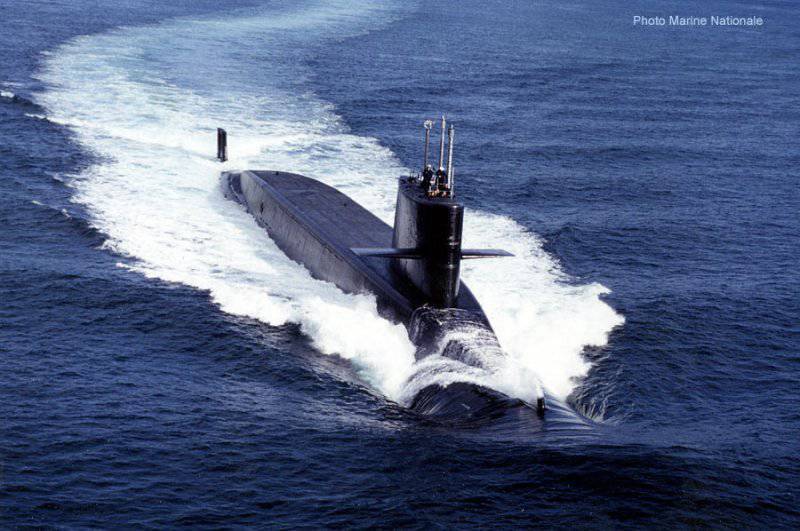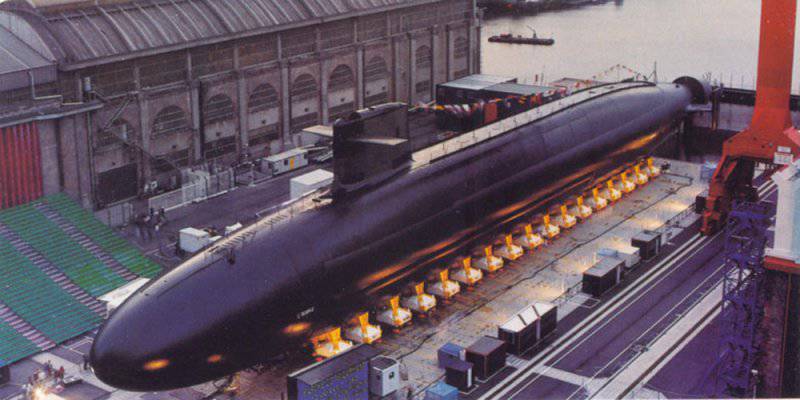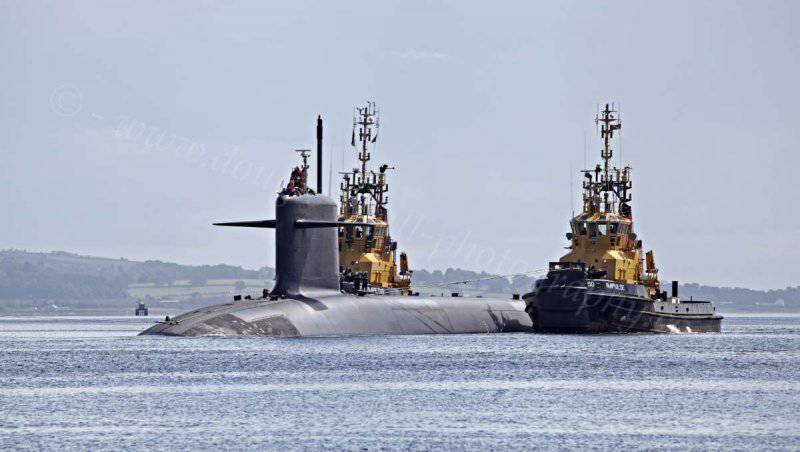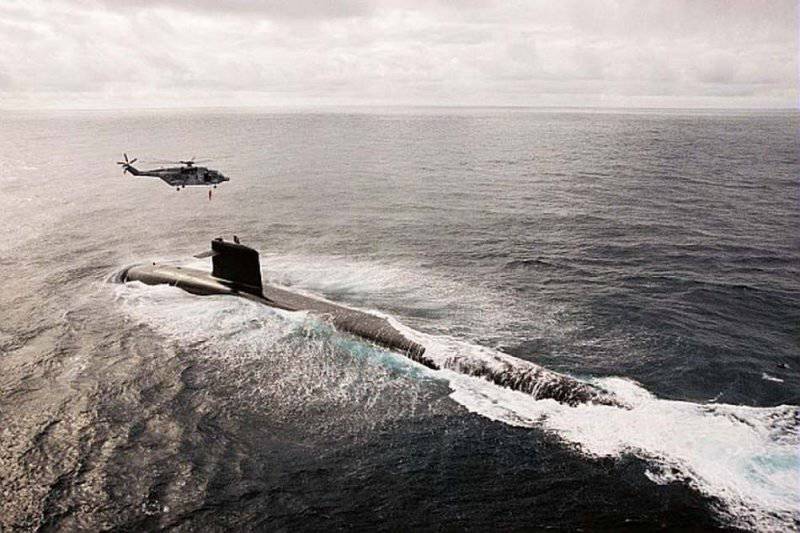French ballistic missiles of type Le Triomphant
The command of the naval forces of France in the late 1970-ies. concluded that the changes that occurred in the operational-tactical situation at that time, caused by the intensification of the Cold War, would lead to the fact that the SSBNs like Le Redoutable would not be able to effectively solve strategic tasks, and the exhaustion of the modernization stocks of these ships would not will significantly affect the combat capabilities of submarines. In addition, physical aging mat. parts of these boats makes it unnecessarily expensive to continue their operation. At the same time, the technological level achieved by the French industry makes it possible to create a missile-carrying ship that will fully meet its objectives.
The design of strategic submarines of the new generation was launched in 1982, two years later, the program for the development of 1987-2010 naval strategic nuclear forces was approved. "Triumfan" was part of this program. In total, before the 2010, it was planned to build six submarines of this series, but after the collapse of the USSR, the global military-political situation changed significantly, and it was decided to limit the series to four ships.
The research work that preceded the beginning of the design of a new submarine led seven groups. The work of the groups was coordinated specifically by the inter-branch organization COELACANTHE, created in 1962 for the creation of the first generation of submarines of French production. The GERDSM group developed the ship’s surveillance equipment, the CERDAN group’s acoustic stealth, the GETDL group’s weapons systems and missile test launches, the GETDL group’s communications equipment, the CERTEL group, the automatic command and control system and the air defense systems and general shipboard systems ( including air regeneration system and ocean development facilities) - CESDA group. It should be noted that such an organization of work was necessary because of the complexity of the task assigned to the designers.
All new submarines were supposed to arm themselves with the developed M5 missiles. The first submarine should have been put into operation in 1991. At first, it should have been armed with M4 missiles. This was done in order to not link the construction of submarines with the development of the M5 system. Replacement of missile weapons, according to the established practice in France, was planned to be carried out during the first overhaul.
Due to delays in the development of the M5 system, they decided to equip the constructed boats with the M45 missiles. М45 - deep modernization of the M4 rocket. The result of this modernization was an increase in the firing range to 5,3 thousand. Km. In addition, the head of the TN-75, having 6 warheads of individual guidance, was installed on the rocket.
The M5 rocket is almost identical in terms of weight and dimensions to the Trident II (D5). This explains the small differences in the design and dimensions of the hull between the Triumfan-type submarines and the American Ohio-type submarines (for example, the Triumfan hull diameter is only 31 millimeter less than the Ohio hull diameter).
When developing a submarine of the “Triomphant” type, two primary tasks were set: first, to ensure a high level of secrecy; second, the ability to detect early means of anti-tank defense (anti-submarine defense) of the enemy, which would give an opportunity to start an evasion maneuver earlier.
To solve the first task, numerous studies have been conducted to determine the probability of detecting a boat using various means of detection, such as optical and sonar search, infrared vision, radar, laser wake path detection equipment and a magnetometer. Surface ships, airplanes, submarines, helicopters, and also artificial satellites of the Earth were considered as probable carriers of these funds. As a result, it turned out that the main unmasking factor is the acoustic field of the submarine and, therefore, the primary task facing the designers is to reduce the noise level of the SSBN.
Given the overall effect on noise, the main attention was paid to the main power plant of the submarine. As well as on other French nuclear submarines, the Triumfan missile carriers were equipped with the K-15 pressurized-water reactor. The peculiarity of this reactor is the natural circulation in the primary coolant circuit. The advantages of this approach are to reduce the noise of the steam generating plant and to increase the reliability of the reactor. It should be noted that a similar scheme was implemented on Ohio-type boats.
When designing Le Triomphant, measures were taken to reduce the noise level to the level of the natural background of the sea (with waves of 0 points). The solution of this problem depended on some technological aspects, such as: optimal hull lines (from the point of view of hydrodynamics), neutralizing the influence of external devices (mainly sliding), de-humming the operation of pumps, electric motors, gearboxes, and the like. The mechanisms used bearings, replacing the noisier rolling bearings (roller and ball), which are widely used on Le Redoutable. For mounting to the hull of the boat of all noise-generating mechanisms used depreciation pads. Each pump and engine, all power cables and pipes are placed in a sheath of vibration-damping elastic material. In turn, the above-mentioned elements are attached to a sturdy body through vibration and noise absorbing plates made of rubber-rubber and / or elastic polymer. Was used the so-called two-stage vibration isolation. All these actions have led to a reduction in noise level in comparison with the "Le Redoutable" and lower than the American Ohio boats.
The design features of the new submarine demanded the modernization of the naval shipyard in Cherbourg, where all the strategic missile carriers were built. The modernization program, which, in essence, involved the shipyard’s transition from the method of building nuclear submarines on an inclined slipway and a dynamic longitudinal descent to the method of horizontal construction and vertical descent, was given the name CAIMAN. It should be noted that by this time the USSR crossed the horizontal structure with a vertical descent, then the United States and Great Britain. The CAIMAN program was conditionally divided into three stages. The first stage is the construction of a new hull workshop, the second is the construction of a pile workshop, the third is a vertical descent device.
SSBNs have always been distinguished by large dimensions. And the Le Triomphant class submarines are the largest in France. navy. Displacement in the submerged state with a length of 138 m is 14335 tons. According to the SNLE-NA program, the length of the 5th and 6th submarines was to be 170 m, however, as already noted, they were refused their order. The diameter of the sturdy hull due to the increased size of the M4 missiles compared to the M5 increased to 12,5 meters. Missile mines protrude from a sturdy hull, but are within the light hull.
The body is assembled from separate sections. The body is divided into compartments (zones) by waterproof spherical bulkheads. In the nose compartment there are torpedo weapons, crew accommodation, as well as a central post and electronic weapons equipment. In the middle part of the hull there is a missile compartment in which 16 rocket shafts are vertically mounted along two lines of the ship’s diametrical plane. The reactor compartment is located behind the missile compartment. It contains the steam generating plant and all the equipment and pipelines of the primary circuit. Behind the reactor compartment is a turbine compartment with a main turbine (a steam turbine unit), a turbine generator of a rowing motor, and a generator used to power the onboard systems of a submarine. In the aft section of this compartment, a propeller motor is installed and the drive to the pump jet propeller.
Above the central post in the front of the hull is mounted fencing mines pull-out devices. In it, besides the shafts of the withdrawable devices, there is a robust cabin. Chipping horizontal rudders are on the fence.
The team of one submarine consists of two crews of 60 people. The duration of one hike is more than 60 days.
A lot of work has been done to improve the hydrodynamic characteristics, since during the movement the submarine can create a noisy stream. Thus, for example, composite materials were used to guard the logging to prevent the “drum surface” effect. For testing the hull and superstructure a special pool was used.
The power plant of nuclear submarines of the type Le Triomphant consists of the main and auxiliary power plants. The main power plant includes a nuclear reactor, a steam generator, a volume compensator, biological protection, a pair of steam turbine plants, a main capacitor, a pair of power generators for the propeller motor and a pair for powering the onboard systems, circulation pumps, a propeller motor, a single-shaft propulsion unit, a propeller, control equipment and management.
The main element of the main power plant is a water-cooled nuclear reactor type K-15, whose power is 150 MW. A similar reactor is installed on the Charles de Gaulle aircraft carrier. French nuclear scientists from the end of 1960's, unlike British and American specialists, began to use low-enriched uranium as fuel in reactors. In the Le Triomphant reactor, uranium is used, the degree of enrichment of which is 7-20%, while in English and American boat reactors it reaches 95%.
The use of low enriched uranium as a fuel for a nuclear reactor has both advantages and disadvantages. The volume of 20% enriched fuel is more than 2-2,5 times than highly enriched. This led to an increase in the size of the nuclear reactor. The life cycle of the core of these reactors under equal operating conditions is 2 times less than the Ohio installed on SSBNs, and therefore requires twice the recharge frequency. But, according to French specialists, the short periods between replacements are quite acceptable, since they coincide with the periods of equipment modernization and weapons (every 5 years), and the relative cost of replacing the fuel is negligible.
The second difference of the K-15 reactor is the combination of a nuclear reactor and a steam generator into one unit. Combining the steam generator and the reactor into one unit allowed the reactor to be made quite compact. Its diameter and height are respectively 4 and 10 meters. It should be noted that these dimensions of the reactor block, including the biological protection, the outer surface of which is a mirror coating. Biological protection during normal operation of the reactor, at full power, provided near the reactor a radiation level equivalent to natural.
Electricity generators generate energy for the operation of the electrical systems of boats. The first, more powerful, ensures the work of rowing electric motors, the second - all other ship systems. The alternating current produced by the first generator is converted into direct current and fed to the rowing motor, with a power of 30,5 MW. Through the shaft, the efforts of the propeller motor are transmitted to the propeller.
The propulsion unit Le Triomphant is performed according to the pump jet scheme, single-shaft, with the shaft located on the axis of the submarine. Seven-blade propeller, with a special form of blades.
The auxiliary power plant consists of a diesel generator, batteries, a propeller motor, a propeller, a device for operating a diesel engine under water, and a control and monitoring system. It provides the movement of the submarine in case of failure of the main power plant or the shutdown of a nuclear reactor, in case of an emergency exit of the missile submarine at sea from the base.
Diesel installation Le Triomphant includes a pair of eight-cylinder diesel engines 8 PA4 V200 SM (power 950 hp or 700 kW).
To improve the maneuverability of the Le Redoutable type submarines, a bow thruster is available at low speed. Probably, a similar device is installed on rocket carriers of the type Le Triomphant.
The control and management system of the auxiliary power plant is made using electronic, pneumatic and computer technologies. Diesel power plant - taking into account the requirements of vibration and shock resistance, various navigation features of SSBNs and climatic conditions.
As the main armament of nuclear submarines Le Triomphant was originally planned to install ballistic missiles M4, which later had to be replaced with the M5 missile system, which was at that time under development. But soon the plans were changed, and the so-called "intermediate" М45, which are an improved version of М4, was installed on the boats. These missiles have a split MIRV warhead with 6 nuclear warheads TN75, 150 power kt. The M5 ballistic missiles (the M51 designation is also used) have 12 nuclear warheads with individual guidance. Their firing range is 10 thousand km (according to other information - 8 thousand km).
Torpedo-missile armament - four 533-millimeter torpedo tubes, from which you can shoot ECAN L5 mod 3 torpedoes or SM-39 Exocet anti-ship missiles. These missiles and torpedoes have proven themselves in the multi-purpose Rubis class submarines.
The radio electronic armament of nuclear submarines Le Triomphant is integrated into a new complex of combat control and tactical data display. It is based on 8 control panels; The information necessary for making a decision comes from a radio-hydroacoustic complex, radio electronic and optical means.
On submarines installed SAC DMUX 80, which was tested in 1996 year. The complex includes hydroacoustic stations DUUX 5 and DSUV 62, as well as hydroacoustic reconnaissance station DRUA 33.
Серия:
S616 Le Triomphant, launched on 1997 g;
S617 Le Temeraire, launched on 1999 g;
S618 Le Vigilant, launched on 2003 g;
S619
Performance characteristics:
Width - 12,5 m;
Length - 138 m;
Draft - 10,6 m;
Surface displacement - 12640 t;
Underwater displacement - 14335 t;
Surface speed - 12 nodes;
Submerged speed - 25 nodes;
Immersion depth - 500 m;
Power point:
- one K15 reactor (thermal power 150 MW);
- rowing electric motor with power 41500 hp;
- auxiliary diesel engines with power 1225 hp;
- one propeller shaft;
Armament:
- torpedo-mine armament - 4 nasal 533-mm torpedo tubes; 10 torpedoes F17 and L5 mod.3;
- Missile armament - 16 mines of the M45 type, (M51 will be replaced), 8 launched from torpedo tubes of Exocet SM39 cruise missiles;
Hydroacoustic armament:
- DMUX 80 complex;
- complex DUXX 5;
- towed GAS DSUV 62;
Crew - 111 people of which 15 officers.
Based on materials:
http://www.warships.ru
http://www.military-informant.com
http://eng.ship.bsu.by
http://www.dogswar.ru
http://www.millitari.ru





Information